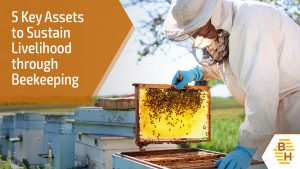Early societies worldwide have consumed honey as raw food or used it for medicinal purposes and traded it at high prices. Raw honey contains numerous antioxidants, vitamins, probiotics, amino acids, minerals, and enzymes that make it an outstanding product to have around.
Bees have the job of keeping the internal temperature of the beehive at a constant 90-95 Fahrenheit This is particularly important in winter regions where bees need to hibernate and survive.
Honey is a natural product, so when extracted, it may have a different texture and color every time. Beekeepers follow a process to filter any significant particles that may affect the look and feel of raw honey and to make it more visually appealing to consumers; some large corporations may go as far as pasteurizing by a heating process which reduces the amount of water, therefore extending the shelf life of honey. But also creating a more uniform look, feel, and texture of the product which would in return be even more appealing to the end consumer.
Heating is a powerful tool used across different industries to sterilize and kill bacteria. In the food industry, heating is used to make certain products safer. In the case of honey, heating is more used to make honey more appealing because honey is already a safe product to eat when raw.
It is important to note that raising the temperature of honey will have a significant impact on its enzymes, antioxidants, and flavonoid content. These nutrients that we gain by consuming natural honey are temperature sensitive; therefore, improperly heating it will destroy the density of these nutrients.
Here are some things you need to know about heating honey.
Can Heat Cause Toxicity in Honey?
One of the biggest concerns and cause of confusion for anyone who uses raw honey is heating it. Heating honey will alter its chemical composition, but it does not make it toxic such that it can harm the consumer. However, the composition of honey changes when heated, and the ingredients are weakened and rendered ineffective.
Impact of Heat on the Properties of Honey
- Honey loses antimicrobial and antibacterial capabilities– When honey is overheated, it destroys enzymes such as invertase and diastase that help in digestion and sugar breakdown. Honey also loses glucose oxidase through heating. It aids the body in fighting bacteria and viruses by producing hydrogen peroxide that works as a disinfectant.
- Honey loses antioxidant properties– Through its antioxidants, honey helps neutralize the effect of harmful radicals in a body that are the sole cause of chronic diseases and infection. One of the primary antioxidants in honey is polyphenols which is an anticancer agent and helps in preventing inflammation. Due to excessive heating of honey, these substances are destroyed.
Key Safety Measures to Take while Warming Honey
Excessive heat or direct heat can have a negative impact on honey. Following are a few safety measures that can be incorporated to warm honey without losing its nutritional value.
1. Use Boiled Water
One of the safest methods of warming up honey is by employing boiled water. In this method, one must boil the water first without the honey. After the water is boiled, put it aside and allow the water to cool down a bit. One can then take the jar of honey and place it inside the warm water to heat it.
2. Use Slow Cooker
Another effective method of warming honey is by using a slow cooker. One must put a container into the slow cooker and fill it with water to the ¾ mark to prevent water from getting into the honey. In the next step, one must turn the slow cooker to the minimum setting and put the container with the honey in the water. The lowest temperature of the slow cooker should not be more than 48.9 degrees Celsius, and it should get the water warm for up to 46.1 to 46.7 degrees Celsius. The container should not be covered with a lid in this method.
3. Use a Honey Warming Blanket
Honey warming blankets have been designed for the sole purpose of heating honey without destroying it. All the other methods of heating honey carry the risk of overheating. A honey warming blanket offers and maintains temperature levels akin to that within a beehive. This solution has inbuilt thermostats that regulate the temperature. The key advantage of the blanket is the fact that it does not need any human presence in order to keep the honey warm. It does not overheat, and few honey warming blanket models also have thermostat regulators that help the user adequately manage temperature levels.
Maintaining Quality of Honey
Bearing in mind the primary question about heating honey – yes, one can heat honey but only by taking safety measures to assure it does not overheat. The methods that any honey company or a beekeeper adopts for handling freshly procured honey from beehives can have a significant impact on the shelf life and the quality of the honey. BeeHively Group takes pride in its handling process. It employs the most ethical and sustainable ways to source the honey and takes extra care while processing and handling it to maintain the quality that is promised to its end-customers.




